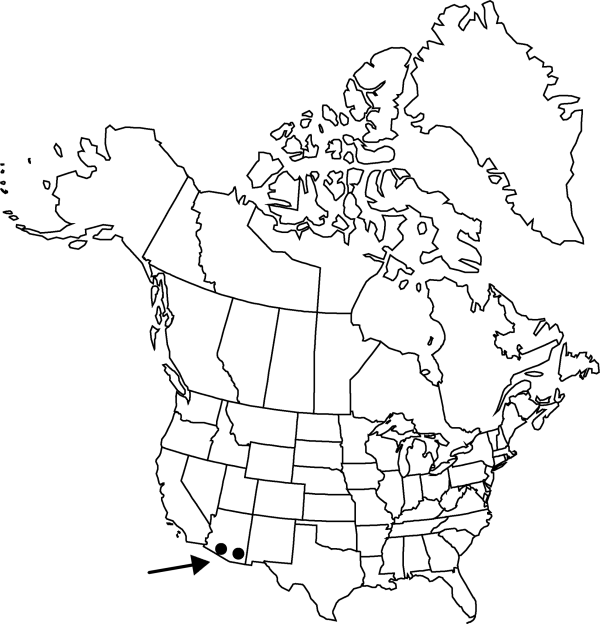Difference between revisions of "Echinomastus erectocentrus"
Cact. 3: 148. 1922.
FNA>Volume Importer |
FNA>Volume Importer |
||
| Line 7: | Line 7: | ||
|year=1922 | |year=1922 | ||
}} | }} | ||
| − | |basionyms={{Treatment/ID/ | + | |basionyms={{Treatment/ID/Basionym |
|name=Echinocactus erectocentrus | |name=Echinocactus erectocentrus | ||
|authority=J. M. Coulter | |authority=J. M. Coulter | ||
| + | |publication_title=Contr. U.S. Natl. Herb. | ||
| + | |publication_place=3: 376. 1896 | ||
}} | }} | ||
|synonyms={{Treatment/ID/Synonym | |synonyms={{Treatment/ID/Synonym | ||
| Line 25: | Line 27: | ||
}}<!-- | }}<!-- | ||
| − | --><span class="statement" id="st-undefined" data-properties=""><b>Stems </b>4–34.5 4–10 cm; ribs 18–21; areoles 8–19 mm apart along ribs; areolar glands present at least seasonally. <b>Spines</b> 13–19 per areole, purplish pink to purple or nearly white with brown tips; radial spines 12–18 per areole; abaxial (shortest) radial spine 6–20 × 0.3–0.6 mm; adaxial and lateral (longest) radial spines 9–37 mm; central spines 1–3(–4) per areole (usually absent from sexually immature plants), erect to ascending, 12–44 × 0.5–0.8 mm; longest adaxial central spine straight to curved upward, abaxial central spine 13–35 mm (absent in <i></i>var.<i> erectocentrus</i>). <b>Flowers</b> 3.6–6 × 4–9 cm; inner tepals whitish to bright rose-pink or lavender, basal portions olive-green to orangish brown, chestnut or maroon, (2–)2.5–4.3 × 0.6–1.8 cm; stigma lobes red to brownish red, papillae red or green. <b>Fruits</b> dehiscent by vertical slits, ellipsoid-cylindric, 12–20 × 5–8+ mm. <b>2n</b> = 22.</span><!-- | + | --><span class="statement" id="st-undefined" data-properties=""><b>Stems </b>4–34.5 4–10 cm; ribs 18–21; areoles 8–19 mm apart along ribs; areolar glands present at least seasonally. <b>Spines</b> 13–19 per areole, purplish pink to purple or nearly white with brown tips; radial spines 12–18 per areole; abaxial (shortest) radial spine 6–20 × 0.3–0.6 mm; adaxial and lateral (longest) radial spines 9–37 mm; central spines 1–3(–4) per areole (usually absent from sexually immature plants), erect to ascending, 12–44 × 0.5–0.8 mm; longest adaxial central spine straight to curved upward, abaxial central spine 13–35 mm (absent in <i></i></i>var.<i><i> erectocentrus</i>). <b>Flowers</b> 3.6–6 × 4–9 cm; inner tepals whitish to bright rose-pink or lavender, basal portions olive-green to orangish brown, chestnut or maroon, (2–)2.5–4.3 × 0.6–1.8 cm; stigma lobes red to brownish red, papillae red or green. <b>Fruits</b> dehiscent by vertical slits, ellipsoid-cylindric, 12–20 × 5–8+ mm. <b>2n</b> = 22.</span><!-- |
-->{{Treatment/Body | -->{{Treatment/Body | ||
| Line 65: | Line 67: | ||
|publication year=1922 | |publication year=1922 | ||
|special status= | |special status= | ||
| − | |source xml=https://jpend@bitbucket.org/aafc-mbb/fna-data-curation.git/src/ | + | |source xml=https://jpend@bitbucket.org/aafc-mbb/fna-data-curation.git/src/f6b125a955440c0872999024f038d74684f65921/coarse_grained_fna_xml/V4/V4_363.xml |
|subfamily=Cactaceae subfam. Cactoideae | |subfamily=Cactaceae subfam. Cactoideae | ||
|genus=Echinomastus | |genus=Echinomastus | ||
Revision as of 21:00, 24 September 2019
Stems 4–34.5 4–10 cm; ribs 18–21; areoles 8–19 mm apart along ribs; areolar glands present at least seasonally. Spines 13–19 per areole, purplish pink to purple or nearly white with brown tips; radial spines 12–18 per areole; abaxial (shortest) radial spine 6–20 × 0.3–0.6 mm; adaxial and lateral (longest) radial spines 9–37 mm; central spines 1–3(–4) per areole (usually absent from sexually immature plants), erect to ascending, 12–44 × 0.5–0.8 mm; longest adaxial central spine straight to curved upward, abaxial central spine 13–35 mm (absent in var. erectocentrus). Flowers 3.6–6 × 4–9 cm; inner tepals whitish to bright rose-pink or lavender, basal portions olive-green to orangish brown, chestnut or maroon, (2–)2.5–4.3 × 0.6–1.8 cm; stigma lobes red to brownish red, papillae red or green. Fruits dehiscent by vertical slits, ellipsoid-cylindric, 12–20 × 5–8+ mm. 2n = 22.
Distribution

Ariz., Mexico.
Discussion
Varieties 2 (2 in the flora).
The populations of Echinomastus erectocentrus north of Tucson, Arizona, are geographically, ecologically, and morphologically intermediate between the two named varieties. Echinomastus erectocentrus is replaced to the northwest by E. johnsonii; the two species are only weakly differentiated.
Selected References
None.
Key
| 1 | Central spines relatively inconspicuous, erect, 1(-2) per areole; abaxial central spine 13-15(-29) mm; inner tepals whitish, pale lavender, or very pale pink, proximally olive green. | Echinomastus erectocentrus var. erectoce |
| 1 | Central spines relatively conspicuous, ascending or abaxial spine porrect, (1-)2-3(-4) per areole; abaxial central spine 25-35 mm; inner tepals pale to bright rose-pink, proximally orangish brown, chestnut, maroon, or greenish brown | Echinomastus erectocentrus var. acunensi |